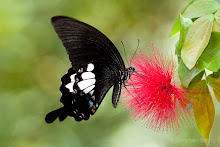It was a rather quiet morning at first, but as it got later,
the sun came out, and so did the butterflies. The Malayan
eggfly, dark glassy tiger and striped blue crow all came down
but didn't stay long. Then the moderately rare large snow flat
came out from beneath the leaves to sun.

At the damp wood chippings patch, I managed to get
some puddlers. The common bluebottle was the first
to come, but it did not settle fully and was difficult to shoot.
It only stayed puddling for a few seconds before moving
to another spot. Here is my best shot of it.

At the edge of the damp area, this elbowed pierrot
was puddling too. I spent over 45 mins trying to get a
nice pic of it. Also pretty hard as there was a trail of biting
ants next to me! But it was all well paid off. Here is my very
own pristine copy of the elbowed pierrot.

There were also many line blues in that area, mostly
tailless line blues. They are small and common butterflies,
often seen puddling. Here is my shot. ( tailless line blue )

Well that's all for today, it was definitely a fruitful trip.
The end and please comment.

























